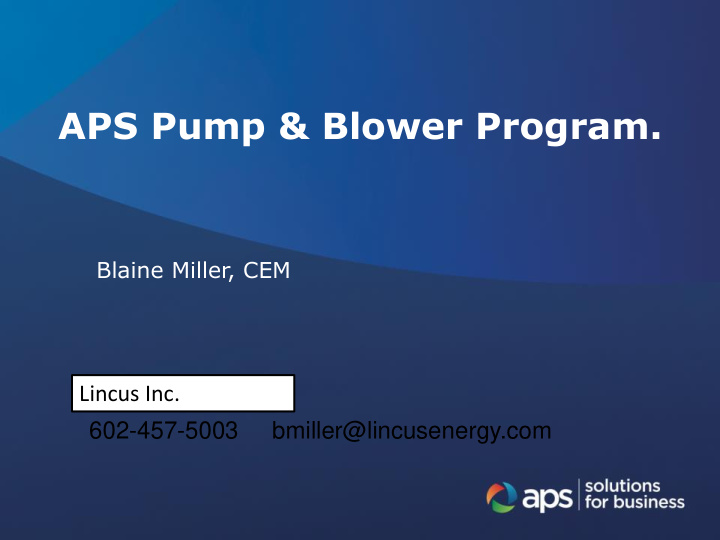



APS Pump & Blower Program. Blaine Miller, CEM Lincus Inc. 602-457-5003 bmiller@lincusenergy.com
Why Pumps for Energy Efficiency? 5% 7% 3% 10% 10% Installation Pump Energy Maintenance 25% Operating 40% Downtime Environmental Optimizing Pumps Systems, Hydraulics Institute & Pump Systems Matter 2
Why Pumps for Energy Efficiency? About 40% of the pump lifecycle cost is spent for energy 3% 5% 7% 10% 10% 25% 40% Optimizing Pumps Systems, Hydraulics Institute & Pump Systems Matter 3
Pumps in Water & Wastewater • Water Distribution Pumps – Booster Station : 700 – 1,200 kWh/MG Pumps in Water & Wastewater – Well Pumps: facilities account 1,000 – 1,800 kWh/MG for (1/7) of AZ state energy • Waste Water Treatment consumption . Plants – System : 1,000 – 3,500 kWh/MG 4
Common Pump Types Deep Well Turbine • Well Pumps Submersible Centrifugal • Booster Pumps Turbine 5
Deep Well Turbine Pumps Most common in well • pumping applications where water is to be pumped out of several hundred feet of depth. Driving mechanism • is located over the surface and a column shaft connects the motor to the pump. Pumps often have • several stages. 6
Submersible Well Pumps Commonly used in • situations where water tables fluctuate considerably over the season and noise is a factor. Often used in • conjunction with booster pumps so as to provide a positive suction head. Motor and pumping • components located beneath the ground surface. Requires less • maintenance. 7
Centrifugal Booster Pumps Commonly used as • booster pumps in water/wastewater systems. Rotational energy of • the impeller converted to pressure energy of water. Can be used for vertical • as well as horizontal water pumping. High Efficiency over • range of operating conditions. Also used in • applications such as chilled water, power plants and industrial pumping. 8
Turbine Booster Pumps Commonly used in • booster stations with multiple pumps. Priming not • needed. 9
Pump System Components Electric Motor Prime Mover Diesel/Gas Engines Air System Piping/Control Valves for flow Column Shaft/Tube Radial Flow Pump Impeller Axial Flow Pump Bowl Assembly 10
Pump Optimization EE Measures Wide variety of EE measures to optimize pump operation and its energy use. These include – – Pump Efficiency (OPE) Improvement Bowl Replacements • Impeller Replacements • – Column Tube/Shaft/Piping Replacements (reduce friction losses) – Right Sizing Pumps – Pump schedule changes (EE/DR) – Pump Sequencing. – System Improvements (match with design conditions). – Prescriptive EE Measures – Variable Speed Drives. • High Efficiency motors. • 11
Pump Optimization Considerations Pump Size Annual System Operational Constraints Hours Pump Optimization Utility Existing Incentives Efficiency Energy Prices 12
Typical Wastewater Processing 13
Major Energy Consuming Equipment Pumps & • Pumps Blowers • Gravity Driven Flow/Solid Seperation account for Primary 80% - 90% of Treatment the total plant energy! • Pumps • Blowers/Aerators Secondary • Process Equipment (Solids) Treatment • Pumps • Lighting Tertiary Treatment 14
Pumps in WW Treatment Plants Pump Systems Primary Pumps Secondary Pumps Tertiary Pumps - Influent Pump(s) - Booster Pump(s) - Booster Pump(s) - Booster Pump(s) Pump Types: Pump Types: Pump Types: - Centrifugal. - Centrifugal. - Centrifugal. - Submersible. - Turbine. - Turbine. Typical Discharge Typical Discharge Typical Discharge Pressure Levels = Pressure Levels = Pressure Levels = 15-30 psig. 0-20 psig. 10-20 psig. 15
Blowers/Aerators Blowers/aerators are • aeration devices that are used for introducing air into the treatment ponds/basins. The ingested air helps in • growing bacteria that could assist in the biological digestion of the raw sewage . Responsible for 50-70% • of total plant energy consumption. www.spencerturbine.com 16 www.hellotrade.com
WW System Benchmarking • ENERGY STAR benchmarking. Web link – http://www.energystar.gov • Other Benchmarking Metrics. – Typical Range is 1,000 – 3,500 kWh/MGD – These metrics are a function of treatment processes. Typical ranges for • Primary = 1,000 – 1,200 kWh/MGD • Secondary = 1,200 – 1,800 kWh/MGD • Tertiary = 2,000 – 3,500 kWh/MGD 17
18
19
20
21
APS Solutions for Business Pump Test & Repair Program • Tests for the Overall Plant Efficiency of individual pumps & blowers • APS covers half the cost of testing • Technical Assistance • • Cash incentives to help cover the cost of studies, could possibly include pump system studies or WWTP audits. Prescriptive Incentive Application • • High-efficiency motor replacement • Installation of VFD $50.00/HP(some restrictions apply) Custom Incentive Application • • All other energy efficiency measures not covered by the prescriptive application • $0.11/first year kWh saved up to 75% of incremental cost • Must pass a TRC test so submit a pre-application 22
APS Solutions for Business • Additional equipment rebates offered in our program include: • Lighting • Cooling • Refrigeration • Whole Building • Will look at any proven energy savings under our custom program 23
Program Requirements APS customer on qualifying rate • • Qualifying rates include E-32, E221, all commercial retail rates > 40% load factor ~ 3,000+ operating hours per year, • per pump >15 hp • 24
Individual Pump Testing 50% off Testing for APS customers for Qualifying Pumps • and Blowers Tests determine Overall Plant Efficiency (OPE) – standard • measurement of pump efficiency Measures head, flow and energy demand • Result shows the hydraulic energy out as a percentage of • electric energy input Regular testing allows owners to • Track the performance of their pumps, • Identify problems before they become critical • Plan for repairs • Identify candidates for improvement • 25
Next Steps • Submit a request form • Gather information on pumping and blower system • Photographs of piping system are helpful • Existence of test ports • Pumps approved for testing • Test Contractor contacts to schedule tests • Test performed • Review Results • Get quote for repairs • Submit a pre-application for incentives • Notification required prior to repair work being performed 26
Q & A 27
Recommend
More recommend